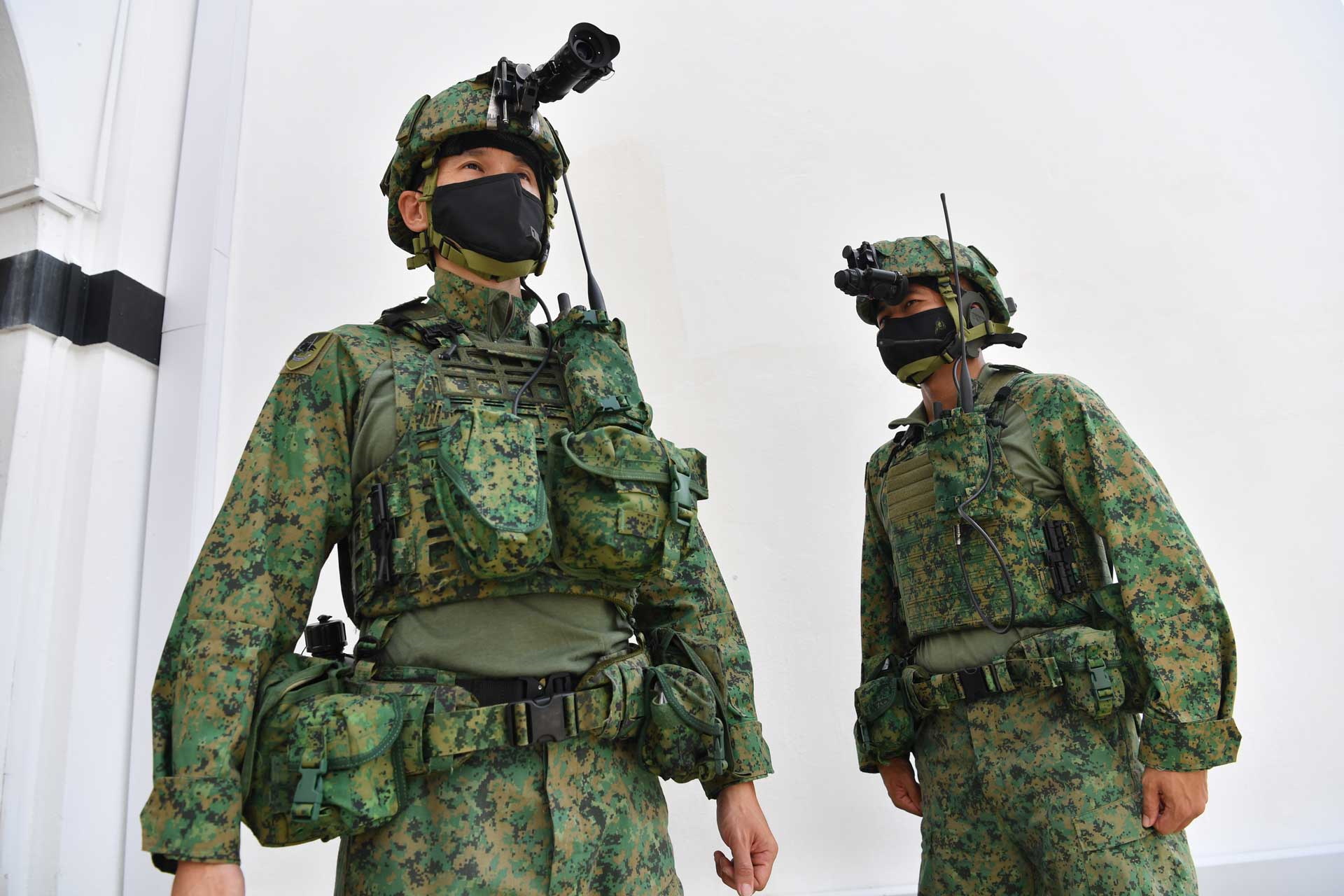ARMY UPDATES PERSONAL EQUIPMENT TO EASE LOADS, IMPROVE COMBAT EFFECTIVENESS
Soldiers can now train and fight more effectively with the improved helmet and Load-Bearing System (LBS).//Story by KOH ENG BENG //Photos by CHUA SOON LYE & CHAI SIAN LIANG
Gone are the days where national servicemen have to struggle to wear their communication headsets together with their helmets, or endure the strains on their shoulders from carrying their personal equipment.
The Singapore Army has launched a new helmet and Load-Bearing System (LBS) that provide a better fit and weight distribution, and are configurable for different missions.
Here's a low-down on the new personal equipment:
The new helmet has a high-cut design which allows soldiers to easily fit their night vision goggles and communication headset. It is 10 percent lighter than the previous version, and comes with an adjustable padding system for better fit and comfort.
Improved heat dissipation & modular design
The LBS replaces the previous integrated Load-Bearing Vest (iLBV). Made of durable and lightweight material, it provides soldiers with better comfort and improves heat dissipation by 30 percent.
The new system comes with detachable components so soldiers can bring just what they need for their mission or training. It has two variants – the LBS (Enhanced) and the LBS (Standard).
Soldiers from combat formations such as Commandos, Guards and Infantry, who go on physically demanding missions, use the LBS (Enhanced) variant. It consists of a LBS (Enhanced) Vest, Body Armour Carrier and belt.
Improved weight distribution
Both LBS variants have multiple adjustable points such as the shoulder straps and belly band to ensure the vest fits snugly.
The LBS components also come in different sizes to fit soldiers of different shapes and sizes. For instance, a soldier can wear a L-size belt with a M-size vest.
Lieutenant Colonel (LTC) Ho Chee Leong, 44, explained how the LBS raises the combat effectiveness of soldiers: "The multi-component system helps them to distribute the load across different muscle groups of the body, hence increasing the soldiers' sustainability out in the field."
The Head of the Centre of Excellence for Soldier Performance (CESP) added: "The fact that you do not need to put on the full configuration - the different components can be attached only when the need arises - again increases the sustainability of our soldiers out in the field."
Development of the LBS
The CESP started the development of the LBS in 2016 and an extensive one-year trial was carried out with soldiers from various formations across the Army.
Human factors engineers studied how the new LBS design affected the mobility of and heat stress on soldiers as they run, climb, dodge and tackle obstacles in the field.
They also analysed anthropometric data (measurements of the human body) from across the Singapore Armed Forces .
"The design is based on our local population. It provides you with better comfort as well as improved mobility when out in the field," said 1st Warrant Officer Heng Song Po, Field Trial Warrant Officer at Soldier Systems Integration Lab, CESP.
The 38-year-old added: "During the trials, we found that LBS is...highly effective in terms of heat dissipation (and) load distribution. And all these are features that soldiers on the ground actually do appreciate."
Who gets the new equipment?
The Army has started equipping Full-time National Servicemen (NSFs) with the new helmets since October last year.
NSFs from combat units have been equipped with the LBS (Enhanced) since January this year. Those from Combat Support and Combat Service Support units will receive their LBS (Standard) from next year onwards.
Operationally Ready National Servicemen (NSmen) will continue to use their existing integrated Load Bearing Vest (iLBV) and helmets as these equipment continue to meet their training requirements.
Only NSmen in selected Artillery units that operate the howitzers are issued with the new helmets which are compatible with their ear protection equipment.
Feedback from soldiers who have used the new personal equipment has been positive.
Officer Cadet (OCT) Emil Harris Bin Jefree, 21, felt that the new helmet and belt were comfortable, and helped him to get used to military training.
"It helped with the training especially since we were new recruits that just entered the force; we had to condition (ourselves gradually) into the (rigours of) training and exercises," he said.
Recruits are first issued with a helmet and belt, which meet their training requirements during Basic Military Training (BMT). They are issued with the remaining LBS components later when they are posted to their units.
Fellow cadet OCT Ajey Jeyakumar, 20, who got his LBS (Enhanced) Vest when he entered Officer Cadet School, felt that it was a good addition as he could easily configure his vest according to the needs of his missions.
He added: "For the helmet, there's the new padding which is very comfortable, and I'm able to rearrange them in a way that fits my head. So it's good as during long missions I've to wear my helmet for long periods of time."










